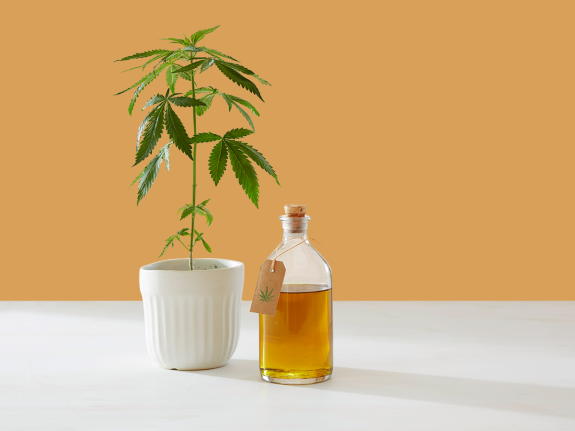
By : Sarah Avakian
Cannabidiol, or CBD as it’s better known, has exploded onto the wellness scene in recent years coming in a variety of products to treat a myriad of injuries, illnesses and disorders. Some you’ll recognize from local stores—they run the gambit from colorfully packaged fruit candies and snacks, to oils, extracts, lotions, and everything in between. CBD was only recently on the fringes of medicine and far from the retail sector, so where’d it come from? How did it get on our grocery and pharmacy shelves?
CBD comes from cannabis, and it’s a cannabinoid like THC but without any psychoactive effect. Because the presence of THC is what defines a Cannabis strain as marijuana, most CBD products are derived instead from Cannabis sativa L, which we call hemp. It’s a simple plant with hundreds of different cannabinoids, but CBD is the one that is now leading an industry estimated to reach a value of $20 billion by 2024. This is not by chance, however, but because of key regulatory, medical and perception shifts that led CBD to its new fanfare:
The Wellness Label is Priceless
Though CBD has entered multiple industries including food and drink, beauty, and pain relief, wellness is a tougher nut to crack. With higher standards and the need to back up assertions that these products genuinely benefit consumers, it’s a testament to the benefits of CBD that it’s now such a wellness industry gem. Itself a market worth $4.2 trillion, there are even several niches of the wellness sector that CBD has yet to enter, giving its potential a certain unignorable momentum.
Jumping Hurdles
Many barriers prevent a new treatment or idea from entering the wellness industry. Vigilant regulators swooping overhead, the heavy burden of medical testimony, and of course the public perception and acceptance of the treatment itself.
International Regulatory Approval
CBD’s mainstream success was delivered on the back of laws passed in the US and Europe at the end of 2018 making hemp-based products (with THC content below 0.3%) legal for manufacture and sale. Though there are a few technicalities that vary between these jurisdictions, what it essentially means is that compliant products are making their way into the marketplace and are easily accessible by consumers without a prescription.
Medical Approval
While lawmakers’ stamp of approval across North America and Europe open doors, the conclusion of a torrent of scientific and medical studies about CBD and its effects were caught regulators attention in the first place. Thrusting CBD into the open were the now-famous cases of MS and epilepsy patients who found CBD to be the only viable treatment for their symptoms—whether taken legally or not. With backup from studies proving efficacy of CBD for PTSD, anxiety, acne, drug addiction, and cancer management, the medical community has given a resounding thumbs up to CBD proving it is not mere snake oil.
Public Perception
CBD was once easily conflated with cannabis or THC, but that has rapidly changed as people begin to understand the medical and wellness differences between the plant strains. A few very public cases stirred immense public sympathy for epileptic children in both Europe and the US who needed CBD to control their seizures. As interest in cannabis-based treatments has risen accordingly, people have come to recognize that CBD is non-psychoactive, will not cause drug test failures and is helpful for addressing everyday issues like muscular and joint pain, anxiety and sleeplessness.
The biggest qualifier for remaining a wellness warhorse is the simple fact that CBD works, and if it didn’t, the market would not be so receptive. A surprising number of people may find that CBD products help for the most common daily struggles which is why offerings from companies like CBDMedic are growing in popularity. Their creams and lotions are blended with CBD to help temporarily relieve things like backache, arthritis, and muscle and joint tension. They’ve also partnered with athletes like Rob Gronkowski, doubtless another contributor to CBD’s stampede into wellness these past few years. Foria is another CBD powerhouse drawing the attention of the wellness crowd, the company’s solutions are directed at those with stress and anxiety issues.
The Future of CBD is Bright
In terms of taciturn government approval at the highest level, CBD has passed muster and now the duck are all in a row. Even the swag bags given to VIPs at the 2019 Oscars were full of CBD products, some of whom used them to ease the night’s high heel pain. For CBD, the Federal Drug Administration is one remaining obstacle, with only Epidiolex (the epilepsy treatment) considered an approved “drug” as of yet. However, the reason Epidiolex works is because it contains CBD, which is about as patentable as valerian root. This is why trustworthy over-the-counter brands have become just as well known, and also why the bureaucratic stringency of the FDA only serves to frustrate the process.
More research is being done on CBD daily, and as it’s inspected from these many angles, no doubt single-purpose CBD spin-offs will continue hitting shelves. If there’s something to take away, however, it’s that CBD is as comprehensively useful as it is complex. Once misunderstood, cannabis and its derivatives like CBD are experiencing a mainstream revival that could not have been predicted at the beginning of the medical marijuana era. It has since been refined by science and safely introduced to a new audience, and one with a larger collective need than ever before.
Sarah Avakian is an LA-Based naturopath with over 20 years experience in the wellness space. Sarah frequently travels the world on research and writing assignments, constantly learning of new natural treatments for health and wellness.


